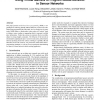IPSN
2004
Springer
14 years 4 months ago
2004
Springer
We present a methodology for a sensor network to answer queries with limited and stochastic information using probabilistic techniques. This capability is useful in that it allows...
SIGOPSE
2004
ACM
14 years 5 months ago
2004
ACM
Wireless ad hoc networks of sensor nodes are envisioned to be deployed in the physical environment to monitor a wide variety of real-world phenomena. Almost any sensor network appl...
SIGOPSE
2004
ACM
14 years 5 months ago
2004
ACM
This paper presents market-based macroprogramming (MBM), a new paradigm for achieving globally efficient behavior in sensor networks. Rather than programming the individual, low-...
SENSYS
2004
ACM
14 years 5 months ago
2004
ACM
We introduce TinySec, the first fully-implemented link layer security architecture for wireless sensor networks. In our design, we leverage recent lessons learned from design vul...
MSWIM
2004
ACM
14 years 5 months ago
2004
ACM
Recent trends in sensor network simulation can be divided between less flexible but accurate emulation based approach and more generic but less detailed network simulator models....
MOBICOM
2004
ACM
14 years 5 months ago
2004
ACM
Sensor networks are often desired to last many times longer than the active lifetime of individual sensors. This is usually achieved by putting sensors to sleep for most of their ...
DMSN
2004
ACM
14 years 5 months ago
2004
ACM
Wireless sensor networks consist of nodes with the ability to measure, store, and process data, as well as to communicate wirelessly with nodes located in their wireless range. Us...
ASPLOS
2004
ACM
14 years 5 months ago
2004
ACM
We present a novel processor architecture designed specifically for use in low-power wireless sensor-network nodes. Our sensor network asynchronous processor (SNAP/LE) is based on...
ACMSE
2004
ACM
14 years 5 months ago
2004
ACM
Sensors are tiny computers with limited computational capability and physical resources. The implementation of secure protocols for sensor network is a big challenge. In order to ...
VLDB
2005
ACM
14 years 5 months ago
2005
ACM
This paper presents a set of algorithms for efficiently evaluating join queries over static data tables in sensor networks. We describe and evaluate three algorithms that take adv...



